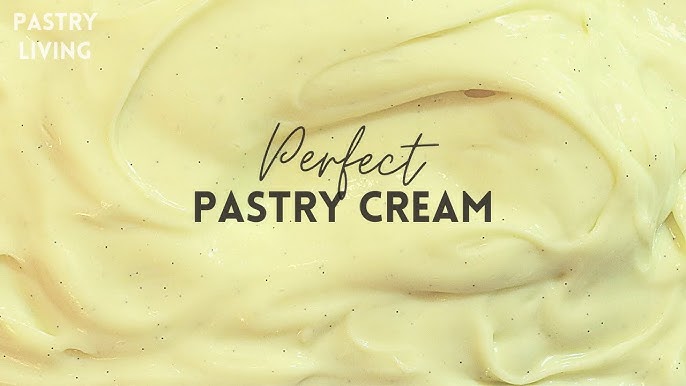Pastry Cream Recipe: If you’re into baking—or even just love indulging in classic pastries—you’ve probably come across pastry cream. Known as crème pâtissière in French, this rich, silky, and smooth custard is the heart of many iconic desserts. Whether it’s filling for eclairs, the creamy layer in fruit tarts, or the luscious center of a Boston cream pie, pastry cream brings a velvety touch that transforms any dessert into something extraordinary.
But don’t let its fancy name scare you off! Pastry cream is surprisingly simple to make at home. You don’t need a professional kitchen or years of baking experience. Just a few ingredients, a bit of patience, and the right technique will have you whipping up this bakery essential in no time.
Why is pastry cream such a baking staple? Aside from its luxurious texture and rich flavor, it’s incredibly versatile. You can flavor it with vanilla, chocolate, coffee, citrus, or just about anything that suits your dessert dreams. Plus, it’s a great base for other pastry essentials like mousseline cream, diplomat cream, or even a quick pudding.
Ready to become a pastry cream pro? Let’s walk through everything step-by-step.
Ingredients You’ll Need
One of the best things about pastry cream is that it doesn’t require any fancy or hard-to-find ingredients. You probably have most of these in your kitchen already.
Basic Ingredients:
- 2 cups whole milk – Whole milk adds richness and gives the cream its smooth texture.
- 1/2 cup granulated sugar – Sweetens the mixture just right.
- 1/4 cup cornstarch – This thickens the cream beautifully without making it grainy.
- 4 large egg yolks – They provide the custard base and richness.
- 2 teaspoons pure vanilla extract – For that classic pastry cream flavor.
- 2 tablespoons unsalted butter – Adds shine and a silky mouthfeel.
- A pinch of salt – Enhances all the flavors subtly.
Optional Additions:
- Vanilla bean paste or pod – For a deeper, more aromatic vanilla flavor.
- Citrus zest – Lemon or orange zest can brighten up the cream.
- Chocolate or coffee – Add melted chocolate or espresso powder for flavor variations.
Each ingredient plays a key role in the outcome. For example, cornstarch is the key thickener here; if you swap it with flour, the cream might end up heavier and less silky. And while butter is optional, adding it at the end gives the cream a glossy, luxurious texture.
Tools and Equipment Required
Before you dive into making pastry cream, it’s important to gather all your tools. This recipe is about timing and technique, and having everything ready makes the process smooth and stress-free.
Must-Have Kitchen Tools:
- Medium saucepan – Preferably heavy-bottomed to prevent scorching.
- Whisk – A balloon whisk works best for incorporating ingredients smoothly.
- Mixing bowls – You’ll need at least one for whisking the eggs and sugar.
- Fine mesh strainer – To strain out any cooked egg bits or lumps.
- Plastic wrap – For covering the cream during cooling to prevent a skin from forming.
- Rubber spatula – Great for stirring and scraping down the sides.
Nice-to-Have Extras:
- Digital thermometer – Helps ensure the mixture doesn’t overheat.
- Piping bag – Useful if you’re using the cream for pastries like eclairs or cream puffs.
- Vanilla bean scraper – If you’re using a vanilla bean pod, this makes extraction easier.
Having these tools handy not only speeds up your process but ensures that your cream turns out smooth and perfectly cooked without any lumps or burnt spots. A heavy-bottomed saucepan is especially important—it distributes heat evenly and helps avoid hot spots that could curdle your cream.
Step-by-Step Guide to Making Pastry Cream
Making pastry cream is all about precision and patience. Follow these steps closely, and you’ll end up with a dreamy, smooth custard perfect for all your baking needs.
Step 1: Prepare the Ingredients
Before you turn on the stove, prep everything. Measure out your ingredients, separate the egg yolks, and set up your cooking station. This will help you avoid rushing or making mistakes once the heat is on. Beat the egg yolks lightly in a mixing bowl and set them aside. Have your milk and cornstarch ready to go. Don’t forget to keep your whisk and fine mesh strainer within reach too.
Step 2: Heat the Milk
Pour the milk into a medium saucepan and place it over medium heat. If you’re using a vanilla bean, split it open and scrape the seeds into the milk, then drop in the pod for extra flavor. Heat until the milk is just about to boil—when you see steam rising and bubbles forming around the edges, it’s ready. Don’t let it fully boil, or you risk scorching the milk.
Step 3: Mix the Egg Yolks, Sugar, and Cornstarch
While the milk is heating, whisk together the egg yolks, sugar, and cornstarch in a separate bowl until the mixture is smooth and pale yellow. This step is crucial—you’re not just mixing; you’re creating the thickening base for your pastry cream. The sugar helps prevent the yolks from curdling when the hot milk is added, and the cornstarch acts as your thickening agent.
You want this mixture to be lump-free and velvety. If it seems too thick to whisk easily, just keep going—it will loosen up once the milk is added. The key here is to whisk vigorously and consistently. If you stop whisking or leave clumps, they’ll show up in your final cream and ruin the silky texture we’re going for.
Step 4: Temper the Egg Mixture
Tempering is a technique where you slowly add hot liquid to eggs so they don’t scramble. It’s one of the most critical steps in this recipe.
Take your hot milk and very slowly pour a small amount into the egg mixture while whisking constantly. This gradually raises the temperature of the eggs without cooking them. Once you’ve added about half the milk, go ahead and pour the egg mixture back into the saucepan with the remaining milk.
Make sure to keep whisking while pouring—this keeps everything moving and prevents any surprises (like cooked egg bits) from showing up in your cream. The goal is a smooth, unified mixture that’s ready to cook.
Step 5: Cook Until Thickened
Return the saucepan to medium heat and start cooking the mixture, whisking constantly. Don’t walk away or turn up the heat too high—this step requires your full attention.
After a few minutes, you’ll notice the mixture start to thicken. It should come to a gentle boil, and that’s when the cornstarch really activates. Keep whisking until the cream becomes thick and glossy. This usually takes about 5–7 minutes.
You’ll know it’s ready when the cream holds its shape on a spoon and doesn’t drip off immediately. If you drag a finger across the back of a spoon coated in cream and the line holds, you’re good to go.
Step 6: Add Butter and Flavorings
Once the cream is thickened and smooth, remove it from the heat. Add the butter and vanilla extract, and whisk until everything is melted and fully incorporated. The butter gives the cream its silky finish, and the vanilla brings that rich, dessert-like aroma we all love.
If you’re using other flavorings—like coffee, chocolate, or fruit purees—this is the time to mix them in. Just be sure anything you add is smooth and well-blended to avoid compromising the texture of your cream.
Step 7: Strain and Cool
Don’t skip this step! Even with all your careful whisking, you might have a few tiny bits of cooked egg in the mixture. Pour the hot pastry cream through a fine mesh strainer into a clean bowl. This removes any lumps and gives you that smooth-as-silk finish.
Press a piece of plastic wrap directly onto the surface of the cream to prevent a skin from forming. Let it cool to room temperature, then refrigerate for at least 2 hours before using. It will thicken even more as it chills and set up into the perfect consistency for piping or spreading.
Common Mistakes to Avoid
Even though pastry cream isn’t super complicated, there are a few pitfalls that can ruin your batch if you’re not careful. Here’s what to watch out for:
Overcooking the Cream
It might be tempting to crank up the heat to speed things along, but this is a big mistake. High heat can curdle the eggs and cause the cream to become grainy or lumpy. Always cook over medium heat and whisk constantly to avoid this issue.
Skipping the Straining Step
Even if your cream looks perfect, always strain it. Those tiny lumps you can’t see right away will become glaringly obvious once the cream is chilled. Straining ensures a perfectly smooth texture.
Not Tempering Properly
This is where a lot of people mess up. Pour hot milk into egg yolks too quickly, and you’ll get scrambled eggs. Pour slowly, whisk constantly, and make sure your egg mixture gradually warms up to prevent curdling.
Chilling Without Plastic Wrap on the Surface
Pastry cream forms a skin if left exposed to air while cooling. Pressing plastic wrap directly onto the surface solves this problem and keeps the top as silky as the rest.
Avoiding these mistakes can be the difference between a sad, lumpy custard and a flawless, bakery-quality pastry cream.
Tips for Perfect Pastry Cream
Want your pastry cream to come out like a pro every time? Follow these bonus tips to elevate your results:
1. Use Fresh, High-Quality Ingredients
Since this is a simple recipe, the flavor of each ingredient stands out. Use fresh eggs, good vanilla extract (or a real vanilla bean), and whole milk for best results.
2. Don’t Stop Whisking
Seriously. From start to finish, the whisk is your best friend. Constant stirring prevents lumps and ensures even cooking. If you stop whisking, the bottom can scorch and ruin the whole batch.
3. Get the Consistency Just Right
Pastry cream should be thick enough to hold its shape, but not rubbery. It should flow slowly when spooned and feel silky on the tongue. If it’s too thick, add a splash of cold milk and whisk until smooth again.
4. Use Immediately or Store Properly
If you’re not using it right away, cool it down quickly to prevent bacteria growth. Always cover it with plastic wrap on the surface and store it in the fridge.
5. Add Flavorings with Care
Pastry cream is super customizable, but don’t overdo it. Too much chocolate or fruit puree can change the texture. Add flavorings slowly and in small amounts to maintain consistency.
Flavor Variations and Customizations
One of the best things about pastry cream is how easy it is to tweak it to match the flavor of your dessert. Whether you want something rich and indulgent or light and fruity, pastry cream can handle it all. Here are some creative ways to customize your base recipe:
1. Chocolate Pastry Cream
Add 4 ounces of chopped dark or milk chocolate to the hot pastry cream after it thickens, just before you stir in the butter. Let it melt completely, then whisk until smooth. This makes a decadent filling perfect for chocolate eclairs or cakes.
2. Coffee Pastry Cream
Stir in 1–2 teaspoons of instant espresso powder with the milk before heating, or add strong brewed coffee in place of a small portion of the milk. This adds a rich coffee flavor that pairs beautifully with chocolate or caramel.
3. Citrus Zest or Extracts
Infuse your milk with the zest of a lemon, orange, or lime as it heats up. Strain it out before tempering with the eggs. You can also add a few drops of citrus extract for a more intense flavor. This variation is excellent in fruit tarts or berry-filled desserts.
4. Fruit-Infused Cream
You can add fruit purée (like raspberry, mango, or strawberry) after cooking the pastry cream. Just make sure to reduce the purée beforehand so it doesn’t water down your custard. Start with 1/4 cup and adjust for taste.
5. Almond or Hazelnut Cream
Add 1 teaspoon of almond extract or hazelnut paste to the finished cream. These nutty flavors work great in croissants or Danish pastries.
The key to custom flavors is to balance intensity and texture. Always add flavorings gradually, and mix well to keep the cream smooth and lump-free. Feel free to experiment—it’s hard to go wrong once you’ve nailed the basic recipe!
Serving Suggestions and Usage Ideas
Pastry cream is like the Swiss Army knife of the dessert world—it can go in, on, or between so many different things. Once you’ve made a batch, here are some delicious ways to use it:
1. Eclairs and Cream Puffs
Pipe chilled pastry cream into these choux pastry favorites for a classic French treat. You can flavor-match your cream to your glaze—vanilla with chocolate, or coffee with caramel.
2. Fruit Tarts
Spread a thick layer of pastry cream inside a baked tart shell, then top with fresh seasonal fruit. Glaze with a bit of warmed apricot jam for that glossy, bakery finish.
3. Layer Cakes and Cupcakes
Use it as a filling between cake layers or inject it into the center of cupcakes. It’s especially good in Boston cream pie or vanilla cupcakes with a surprise inside.
4. Napoleons and Mille-feuille
Layer pastry cream between sheets of puff pastry for this iconic dessert. Top with a layer of icing or powdered sugar for that signature finish.
5. Breakfast Pastries
Danishes, croissants, and morning buns get a serious upgrade when filled with or swirled with flavored pastry cream.
The possibilities are endless. You can even enjoy it by the spoonful, chilled from the fridge, topped with berries or a sprinkle of cinnamon. It’s that good!
Storage and Shelf Life
After all your work, you definitely want to make sure your pastry cream stays fresh and safe to eat. Here’s how to store it properly:
1. Refrigeration is a Must
Always store pastry cream in an airtight container in the refrigerator. It contains eggs and dairy, which are perishable. It should be cooled completely before refrigerating to avoid condensation, which can water it down.
2. Use Within 3–4 Days
Pastry cream is best used within 3 to 4 days. After that, the texture may change, and it could start to spoil. Always check for any off smells or changes in appearance before using.
3. Can You Freeze It?
Freezing pastry cream isn’t ideal. The texture becomes grainy and watery once thawed, especially if it was thickened with cornstarch. If you absolutely must freeze it, beat it well after thawing and expect a slight texture change.
4. Reviving Cold Pastry Cream
Once it’s been chilled, pastry cream may stiffen slightly. Just give it a good whisk before using to bring it back to its smooth, creamy texture. You can add a splash of milk if it seems too thick.
Proper storage ensures your pastry cream stays safe, tasty, and ready for whenever inspiration strikes.
FAQs about Pastry Cream Recipe
What is pastry cream used for?
Pastry cream, or crème pâtissière, is a rich, creamy custard thickened with flour or cornstarch. It’s a versatile player in the baking game, starring as a filling for eclairs, fruit tarts, and cream puffs. You can also find it layered in trifles or dolloped onto cakes for an extra lush touch.
Can I make pastry cream without eggs?
Yes, you can! For those dodging eggs, you can use cornstarch or a similar starch as the main thickener. This version won’t be as rich as the traditional recipe but fear not—it’ll still bring a creamy satisfaction to your desserts.
How long does homemade pastry cream last?
Pastry cream can play it cool in the fridge for up to three days, covered snugly with plastic wrap to avoid forming a skin. It’s a bit of a diva in that way—doesn’t really like to hang out too long before it starts throwing a fuss (read: it can separate or spoil).
Can pastry cream be frozen?
Technically yes, but brace yourself for a texture change once it’s thawed. Freezing can cause the silky cream to become a bit grainy. If you’re cool with that, freeze away. Otherwise, it’s best enjoyed fresh!
What’s the secret to smooth, lump-free pastry cream?
Slow and steady wins the race here. Whisk constantly when you add your milk to the egg mixture, and keep the flame low to avoid cooking the eggs too fast. Strain the mixture through a fine sieve if you suspect any lumps are plotting a takeover.
Can I flavor pastry cream with something other than vanilla?
Absolutely! Feel free to infuse your pastry cream with citrus zest, chocolate, coffee, or even spices like cinnamon or nutmeg. Let your taste buds lead the way and experiment with flavors that tickle your fancy.
Conclusion
Pastry cream might sound fancy, but with a little care and the right steps, it’s surprisingly easy to master. From its silky smooth texture to its sweet vanilla aroma, this creamy custard is the foundation for countless classic desserts. Whether you’re filling a tart, topping a cake, or just enjoying it by the spoonful, pastry cream always delivers comfort and elegance in one bite.
By understanding the technique, avoiding common mistakes, and experimenting with custom flavors, you can make this recipe your own. It’s a skill every home baker should have in their arsenal. Once you’ve tried it, you’ll wonder how you ever baked without it.



